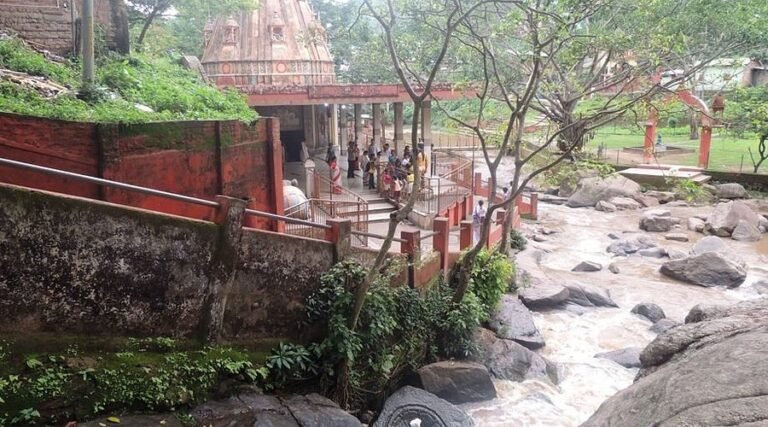
Now, the Anangha — the formless one — has to regain a form. It is time for Kamadeva, who was once reduced to ashes by the fiery glance of Shambhu, to be reborn. But nothing in this creation happens without purpose. The depth of a tunnel cannot be analysed by standing on the surface.
This is not just about resurrection — it is about karmic culmination and the unfolding of Mahamaya’s plan. The curse must lift where Amba’s Yoni — the supreme source — fell. That place is Kamarupa, the seat of Kamakhya.
Rati and Kamadeva were filled with joy, yet their hearts ached watching Mahadeva still immersed in grief. The fire of past karma still burned silently within.
They approached Vishwakarma, the celestial architect, and unfolded their story, including the path for Kamadeva to regain his divine form. Vishwakarma, the master of divine blueprints, agreed to aid Rati and Ratipati.
Together, Rati, Kamadeva, and Vishwakarma undertook a sacred task — to erect a temple in Kamarupa, right where her Yoni fell. To protect and empower this kshetra, they also invoked the presence of the 64 Yoginis and Hetukadi Bhairavas. This wasn’t just architecture — it was a multidimensional yantra brought into form.
Now that the kshetra is built around her Yoni, Kamadeva got back his swarupa. The form returns to the formless when it aligns with the source.
But Mahamaya’s leela was far from over.
The time had come for Narakasura — the asura king — to enter the scene. He had taken refuge in Kamarupa and was a fierce devotee of Kamakhya Amba. Through intense tapas, he had earned boons from her. But during one darshana, he was overtaken by her beauty and desired to marry her.
This, too, was Mahamaya’s orchestration — for something else had to unfold through this desire. She smiled — not out of acceptance, but because the future had to arrive. She did not get angry; instead, she placed a condition that only she — the Supreme — could design.
He must build a temple, a tank, and a stone pathway from the Brahmaputra foothills up to the top of Neelachala Parvata — all in a single night.
Narakasura — consumed by arrogance — thought this an easy task, forgetting who he was dealing with. He forgot she is Mahamaya.
Blinded by his ego, he began the task, powered by his asuric strength. But just before he could finish, Mahamaya made a cock crow, and he believed dawn had broken. In disbelief and despair, he abandoned the task.
Amba, with her cosmic calm, declared — he had failed, and she would not marry him.
Still, Narakasura retained his boons, and with them, he became a terror. His devotion was real, but not righteous. The play of Mahamaya is not partial — not all her devotees remain good, and not all evil is forever punished. What is sown must be reaped.
A devotee of good character attains her abode;
a devotee of bad character receives the karmic fruit in Naraka.
During this phase of inflated ego, Vashishta Maharishi arrived at Kamarupa to have darshana of Kamakhya Amba. But Narakasura — puffed with pride — denied the rishi entry. His guards turned the great Maharishi away from the temple.
Vashishta — enraged not just at Narakasura, but at Amba’s silence — cursed both:
“Kamakhya will abandon you, Narakasura. Your downfall is near.”
“And from now on, Kamakhya will be worshipped only through the left-handed path — Vamachara.”
That was the beginning of the decline.
From that moment, the worship of Kamakhya shifted away from saumya and sattvika, and became overrun by Vamachara — misunderstood, misused, and misdirected by those who no longer saw her as the Mother.
But even in this, Amba had left a message —
“I am to be worshipped as the Divine Mother, not desired like a woman.”
The learned ones remember this. They resist the curse of Vashishta and worship her with the purity that befits Jagadamba.
“But will this not incur the wrath of Vashishta Maharishi?”
Yes, it might.
But Mahamaya always protects those who walk in truth, even if she does so in hidden and unexpected ways.
Before leaving, Vashishta Maharishi took a vow to remain on Neelachala Parvata until Narakasura fell. His ashrama still exists there — the Vashishta caves that we visit even today.
Thus, this episode of Kamakhya Tattva Bodha ends — with a clear call:
Not every worship is divine.
Not every devotee is worthy.
And not every curse is a punishment — sometimes it is a test.
You shall click here to get our ebook of Kamakhya Tattva Bodha.

